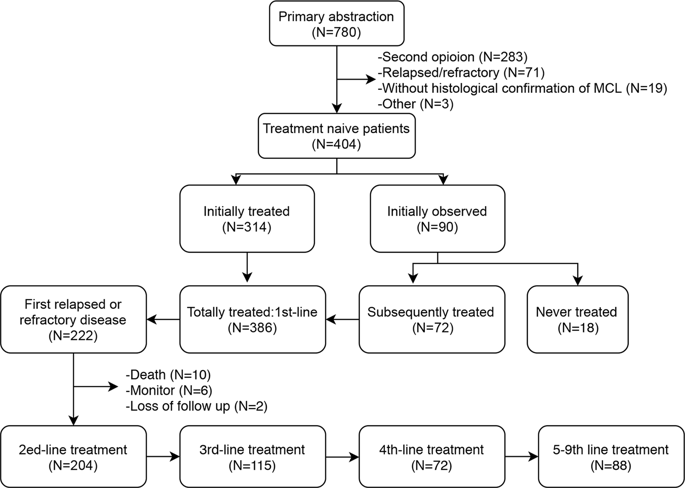当前位置:
X-MOL 学术
›
Blood Cancer J.
›
论文详情
Our official English website, www.x-mol.net, welcomes your feedback! (Note: you will need to create a separate account there.)
Patterns of survival in patients with recurrent mantle cell lymphoma in the modern era: progressive shortening in response duration and survival after each relapse.
Blood Cancer Journal ( IF 12.8 ) Pub Date : 2019-05-20 , DOI: 10.1038/s41408-019-0209-5 Anita Kumar 1 , Fushen Sha 1 , Ahmed Toure 1 , Ahmet Dogan 2 , Andy Ni 3 , Connie L Batlevi 1 , Maria Lia M Palomba 1 , Carol Portlock 1 , David J Straus 1 , Ariela Noy 1 , Steven M Horwitz 1 , Alison Moskowitz 1 , Paul Hamlin 1 , Craig H Moskowitz 1 , Matthew J Matasar 1 , Andrew D Zelenetz 1 , Anas Younes 1
Blood Cancer Journal ( IF 12.8 ) Pub Date : 2019-05-20 , DOI: 10.1038/s41408-019-0209-5 Anita Kumar 1 , Fushen Sha 1 , Ahmed Toure 1 , Ahmet Dogan 2 , Andy Ni 3 , Connie L Batlevi 1 , Maria Lia M Palomba 1 , Carol Portlock 1 , David J Straus 1 , Ariela Noy 1 , Steven M Horwitz 1 , Alison Moskowitz 1 , Paul Hamlin 1 , Craig H Moskowitz 1 , Matthew J Matasar 1 , Andrew D Zelenetz 1 , Anas Younes 1
Affiliation

|
As the survival of patients with mantle cell lymphoma (MCL) continues to improve, patients are increasingly being treated with multiple regimens. However, outcome after each line remains poorly characterized in the modern era. To address this knowledge gap, we retrospectively studied 404 consecutive MCL patients who were managed between 2000 and 2014 at Memorial Sloan Kettering Cancer Center. Histologic diagnosis was centrally confirmed, and patients were followed longitudinally from diagnosis throughout their disease course. Progression-free survival (PFS) and overall survival (OS) were determined by Kaplan-Meier method. The median OS and PFS after first-line treatment were 9.7 and 4.0 years, respectively. After second-line therapy, the median OS and PFS were 41.1 and 14.0 months, third line were 25.2 and 6.5 months, and fourth line were 14.4 and 5.0 months. In patients less than 65 years, stem cell transplant (SCT)-based frontline regimens were associated with improved PFS compared with non-SCT regimens (median PFS: 86.2 versus 40.0 months; P < 0.01), with a trend toward longer OS (median OS: 165.0 versus 120.0 months; P = 0.06). Early treatment failure after first-line regimens was associated with worse OS (5.9 versus 2.5 years; P < 0.01). Our study should facilitate establishing proper endpoints for future clinical trials using novel treatment approaches.
中文翻译:

现代时代复发性套细胞淋巴瘤患者的生存模式:每次复发后反应持续时间和生存期逐渐缩短。
随着套细胞淋巴瘤(MCL)患者的生存率不断提高,越来越多的患者接受多种方案治疗。但是,在现代中,每行之后的结果仍然没有很好的特征。为了弥补这一知识差距,我们回顾性研究了404名在2000年至2014年之间在纪念斯隆·凯特琳癌症中心接受治疗的MCL患者。组织学诊断得到了中央确认,并且在整个病程中对患者进行了纵向诊断。无进展生存期(PFS)和总生存期(OS)通过Kaplan-Meier方法确定。一线治疗后OS和PFS的中位数分别为9.7年和4.0年。二线治疗后,中位OS和PFS为41.1和14.0个月,三线为25.2和6.5个月,四线为14。4和5.0个月。在不到65岁的患者中,与非SCT方案相比,基于干细胞移植(SCT)的一线治疗方案与PFS改善相关(中位PFS:86.2个月对40.0个月; P <0.01),并且有更长OS的趋势(中位OS:165.0对120.0个月; P = 0.06)。一线方案后的早期治疗失败与OS恶化有关(5.9对2.5年; P <0.01)。我们的研究应有助于使用新的治疗方法为将来的临床试验确定合适的终点。一线方案后的早期治疗失败与OS恶化有关(5.9对2.5年; P <0.01)。我们的研究应有助于使用新的治疗方法为将来的临床试验确定合适的终点。一线方案后的早期治疗失败与OS恶化有关(5.9对2.5年; P <0.01)。我们的研究应有助于使用新的治疗方法为将来的临床试验确定合适的终点。
更新日期:2019-11-18
中文翻译:

现代时代复发性套细胞淋巴瘤患者的生存模式:每次复发后反应持续时间和生存期逐渐缩短。
随着套细胞淋巴瘤(MCL)患者的生存率不断提高,越来越多的患者接受多种方案治疗。但是,在现代中,每行之后的结果仍然没有很好的特征。为了弥补这一知识差距,我们回顾性研究了404名在2000年至2014年之间在纪念斯隆·凯特琳癌症中心接受治疗的MCL患者。组织学诊断得到了中央确认,并且在整个病程中对患者进行了纵向诊断。无进展生存期(PFS)和总生存期(OS)通过Kaplan-Meier方法确定。一线治疗后OS和PFS的中位数分别为9.7年和4.0年。二线治疗后,中位OS和PFS为41.1和14.0个月,三线为25.2和6.5个月,四线为14。4和5.0个月。在不到65岁的患者中,与非SCT方案相比,基于干细胞移植(SCT)的一线治疗方案与PFS改善相关(中位PFS:86.2个月对40.0个月; P <0.01),并且有更长OS的趋势(中位OS:165.0对120.0个月; P = 0.06)。一线方案后的早期治疗失败与OS恶化有关(5.9对2.5年; P <0.01)。我们的研究应有助于使用新的治疗方法为将来的临床试验确定合适的终点。一线方案后的早期治疗失败与OS恶化有关(5.9对2.5年; P <0.01)。我们的研究应有助于使用新的治疗方法为将来的临床试验确定合适的终点。一线方案后的早期治疗失败与OS恶化有关(5.9对2.5年; P <0.01)。我们的研究应有助于使用新的治疗方法为将来的临床试验确定合适的终点。



























 京公网安备 11010802027423号
京公网安备 11010802027423号